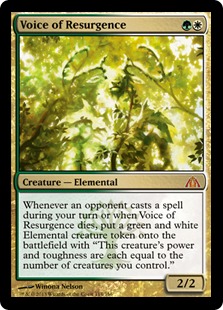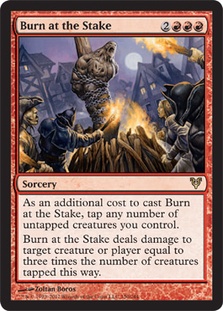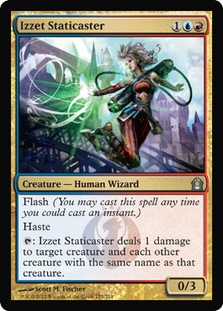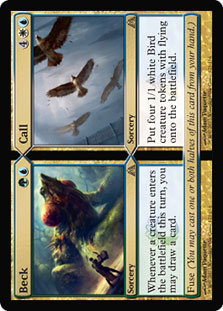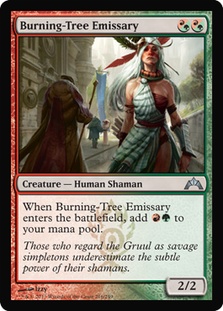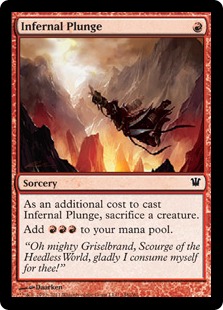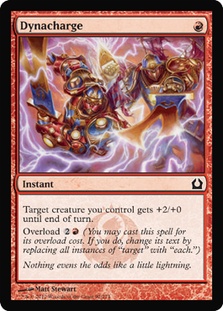Good morning folks!
(Today, I’m going to take a slight detour from the beaten path of tuned competitive decks. I’m not saying this article won’t contain a possibly competitive deck, but I’ve been playing Jund recently and honestly, who wants to read about the latest iteration of Jund Midrange?)
I just want to say…
Thank you, Voice of Resurgence.
You’re welcome.
You have let me be a bad player yet again.
I have a terrible condition, one that I’ve had it ever since I came back to the game months ago. Every couple of weeks, I check the metagame, I look at popular sideboard choices, and I ponder the implications of big metagame shifts. I pour over each list from the Top 16 of the latest Standard Open. All so…
I can figure out if I can bust my Burn at the Stake deck back out yet.
It’s bad, I know. A hindrance on my progression as a player. A brief, fleeting hope that I can actually cook up new ideas and play a 14th tier deck to prominence purely through player skill. I’d like to think I can brew, as I tend to come up with ideas early that end up working (albeit not in my hands), but this tendency to try out Burn at the Stake when you could just be playing exciting cards like Thragtusk, Farseek, and Sphinx’s Revelation…
Well, why punish myself with a boring, redundant deck like Burn at the Stake when I could ride the lightning with the terrible terrific trio!?
It’s because I can only take so much ‘tusking.
What if I can just go over the top?
It all started here; my first game with the deck involved a turn 4 win after my opponent dropped a turn 3 Thragtusk followed by a Restoration Angel on the play. I think I’ve been hooked ever since. Doing unfair things and playing an Izzet-based deck is what I’ve always enjoyed doing. Drawing cards, making creatures…drawing more cards, making more creatures…amassing my mob so I can tie my opponent up and Burn them at the Stake.
Just typing about it gets me excited.
So recently, after the printing of Dragon’s Maze provided nothing of real benefit to my little deck that could(n’t) (and yes, I’ve checked after every set gets spoiled for any new cards that might push the deck up to the 13th tier), I put the deck aside yet again, playing Jund in Baltimore to a mediocre/bad 7-3 record, good enough to just miss making any cash. It was boring. It was frustrating. But it was also exciting.
Why?
Junk Reanimator isn’t on top anymore.
You see, even though Dragon’s Maze didn’t directly give the deck any wheels, it did give other decks the power to push Junk Reanimator out of the limelight. What does that mean?
Less of these in sideboards!
Rest in Peace was the one card that made it impossible to even consider playing Burn at the Stake even if the deck was in fact viable—which is in and of itself quite debatable. You had a hard enough time winning when your opponents had minimal interaction; if they could just slam a Rest in Peace, you pretty much couldn’t win, honestly.
Additionally, Junk Reanimator also invited the usage of a little card we like to call “Izzet Staticaster.” When your entire deck focuses on getting out 1/1 tokens with the same name…
I’ll let you finish that story yourselves. It’s too painful for me to recall.
On that same note, the uptick in the amount of Voice of Resurgences seeing play has another added benefit: decks that play Voice don’t want to play Rest in Peace because it turns off Voice. Other decks are playing Ground Seal, which does absolutely nothing against Burn at the Stake.
So when I noticed this trend, I got excited to sleeve this number back up:
Creatures (4)
Lands (21)
Spells (35)
- 4 Prophetic Prism
- 4 Past in Flames
- 1 Infernal Plunge
- 4 Faithless Looting
- 4 Gather the Townsfolk
- 4 Secrets of the Dead
- 4 Reforge the Soul
- 4 Battle Hymn
- 1 Burn at the Stake
- 4 Krenko's Command
- 1 Aurelia's Fury
Sideboard

After trying a few hands out, I immediately remembered why I both loved and loathed the deck. You see, there are games where you feel like you are an actual combo deck; your Faithless Lootings almost feel like Brainstorms and your Reforge the Souls feel like Time Spirals, leading to a glorious reproduction of a scene straight out of the Salem Witch Trials.
Then there are the games where you just draw the wrong order of cards or get flooded. Or the games where you do anything other than drawing everything you need in the order you need it.
Consistency was ne’er ‘er strong point, cap’n…
I tried coming up with alternatives. I was like that desperate kid whose girlfriend just told him that she didn’t think it was quite working out but hadn’t fully ripped the proverbial Band-Aid off. I was grasping at straws, thinking that if I could just find that one card that I, Michael Martin, could find a way to cure all which ailed the deck.
So I did what I always do: fired up Gatherer and started pouring through every single card in Standard that was within the colors I was in.
I was finding nothing. The problems with the deck were too many to be solved by one card. Token producers, mana producers, card draw…what card could do all that at once?
Turns out, none. However, while looking through a search for blue cards in Standard, one card caught my attention that changed the way I built the deck entirely:
When this card was spoiled, I, like everyone else, immediately thought of how it would impact Elves in both Modern and Legacy. There just weren’t enough things to do in Standard to break the card.
Or were there!?
…
…
…
Here’s a little story about burning:
I have a seven-year-old stepson named Chris. That little man is adventurous, follows me around everywhere, and emulates my every move. It’s like I have a protege, and I’m loving every minute of it. I get him to do the most outlandish things—to the frustration of his mother.
A couple of years ago, after yet another viewing of the classic Tenacious D in The Pick of Destiny, I randomly yelled out to Chris to give me a power slide in the middle of the grocery store. Since the tile floors had enough dust collected since their last good sweeping, I knew Chris could slide effortlessly. So I showed him how it was done, and that, as they say, was all she wrote.
He started power sliding over and over again in the store. Then he tried it on the kitchen floor.
Then he tried it on the living room floor.
On the carpet. Immediately tore a hole in the knees of his old jeans.
And also immediately got introduced to his first rug burn.
(Not to say that stopped him; we’re still buying new pants all the time even though we long ago told him to stop. Payback and all…)
So, like Chris’s painful introduction, I want to introduce you to the Magic Rug Burn:
Creatures (13)
Lands (20)
Spells (27)

This deck can relatively consistently go off between turns 4 and 6 assuming you’re able and willing to set up your turns well in advance (and also not considering the opposing interaction, which obviously plays a role). You have to plan multiple turns into the future so you can sequence your plays in the current turn.
The deck is similar in concept to the U/W/R version of the deck but also vastly different in execution. You still aim to get creatures in play, Battle Hymn, play more stuff, and draw more cards, with the end state being “cast Burn at the stake for more than your life total.” However, the path to that end goal has changed.
First, upon discovering Beck // Call, I realized that I needed to shift colors. While losing white would cause the loss of the second of two core token-producing spells, you would gain access to a better/more reliable card draw spell (Beck vs. Reforge the Soul and Secrets of the Dead) in addition to another card I’ve wanted to run since I started trying the deck out:
Another creature-producing spell that could get us access to more than one creature for two mana, Burning-Tree Emissary was always on my radar; the problem was that when comboing off you only had access to red mana, which was necessary to continue comboing. Emissary would filter two red into a red and a green, the green mana being completely useless other than as a colorless mana source without Prophetic Prism. That concern alone prevented me from trying the card out.
However, knowing I’m going to be playing blue and green for Beck // Call in addition to obviously being Red for Burn at the Stake, I knew I could better use the filtered mana in this deck. I could even include spells solely to take advantage of the green mana.
Like Elvish Visionary.
Or Young Wolf.
At first, I had Arbor Elf in the deck as the one-mana green creature to take advantage of extra green mana on Beck turns (similar in concept to “Glimpse turns” in Legacy Elves—turns in which you have an active Beck drawing you cards). However, that required me to play a full playset of Breeding Pools, and even then they weren’t reliable. If I ever dropped a turn 1 Arbor Elf, I already felt behind somehow. I can’t explain it—it was a feeling—but I rarely won those games.
Enter Young Wolf.
In addition to being great against early aggression from Naya / R/G, it also gives me an outlet to use that pesky green mana. At first, I considered it almost a throw-in—something slightly better than Arbor Elf for what my deck is trying to do—but I can honestly say that I won’t go below two now.
Why?
This card and I have a troubled history. I have always wanted to include some number of Plunges because of the need for additional ritual effects, but due to the fact that it removes a creature from the table and hurts both Battle Hymn and Burn at the Stake, I’ve always been hesitant to take the plunge.
But…
Young Wolf sticks around post-Plunge.
And when are we going to go Plunging? On our Beck turns, obviously (unless we’re winning that turn with a Burn at the Stake). What’s that, Young Wolf? You say that you enter the battlefield all over again after Plunging?
And class, what does that mean?
With Young Wolf, your Infernal Plunge goes from liability to an excellent ritual effect that cantrips.
Everything else should be rather self-explanatory, with the possible exception of the Thatcher Revolt. Those are meant to give you ways to draw more cards and have more tokens for the Beck turns that you go off on; they’re better on those turns than another Elvish Visionary since you can flash them back with Past in Flames, and even on “mini Beck turns” you can simply play Beck then Revolt for three more cards to dig you further into your deck.
That’s another concept I want to hit on as well; “mini Beck turns.” If you are adventurous enough to play this deck, you’re going to have to get used to the concept of mini-Becks. It’s the best way to draw cards in this deck, and with Past in Flames you don’t mind using it early since you can always reuse them later. It’s not easy to flashback a Beck after casting Past in Flames, but between Goblin Electromancer reducing the cost of Past in Flames (giving you more access to colored lands to pay for Beck) and cards like Burning-Tree Emissary and Prophetic Prism to filter your red mana from Battle Hymn/Infernal Plunge, it’s easy enough to set up as long as you plan ahead before you start casting spells.
How the Deck Plays
Intricacy is an understatement. This deck is a case study in knowing your role in the game at hand and knowing when to “go for it” and when to wait until you have more resources to go off. There are so many things to consider when playing this deck. For example, you need creatures in play to power up Battle Hymn, but you need to have creatures (or token producing spells; when I use the term “creatures,” I’m pretty much always going to also mean these spells as well) in hand for when you start going off with Beck. Do you go ahead and play some creatures now so you can Battle Hymn early in the turn on your next turn? Do you hold them back so you can drop them post-Beck and then play Battle Hymn?
There are so many quandaries like that with this deck that only get “solved” by extensive practice. There are still plenty of situations where I have no idea what the “right” play is and I just go with my gut.
Brief aside: To answer the previous quandary about creatures in hand vs. in play, it simply comes down to planning out your next turn and what’s in your hand. Imagine how many creatures you can get in play based on the amount of lands you have in one turn before you have to cast Battle Hymn, and then try to figure out if that amount of mana from Hymn is going to be enough to continue “going off”. If it’s not, you’ll probably have to cast a creature or two now to build up for later. Also, consider whether you think your opponent will remove those creatures as well.
For example, it’s almost always correct to just cast Young Wolf early since you’ll want it if your ritual effect ends up being Infernal Plunge. If you don’t have a Beck // Call in hand, you also need to figure out if you’re under any kind of real pressure to go off now or not; if not, just wait until you draw it or come under pressure. If so, you have to weigh the pros and cons of just playing out your hand; can you win with what you have in hand? Is it even possible? If not, it might be better to just try to wait it out anyway and get a bit lucky.
I could keep typing out tips and tricks, but it would take an entirely new article (and then some) to get it all down. If you want to play the deck, I’d definitely suggest sitting down and just goldfishing for a while, gaining an understanding of how to set up turns that you go off and when you have to just go for it without a ton of reliable ways to continue “going off” while living off the top of your deck. Again, don’t be afraid to “mini-Beck”—it’s the best way to draw you further into your deck (and you even get to use it later with Past in Flames, so holding it doesn’t do anything beneficial).
How a typical game plays out:
On turn 2, you start casting cantrips. You usually don’t do anything on turn 1, as paying two life for a Young Wolf really isn’t worth it unless you’re staring down a Stromkirk Noble. When given the choice, I usually go with Prophetic Prism because it cantrips and I get to keep a creature in hand for later.
On turn 3, if you have no land drop, cast more cantrips. If you do, unless you’re close to going off, I wouldn’t cast much of anything other than a Goblin Electromancer. (If you can cast Electromancer on turn 2, go for it, but realize it’s probably just going to get killed. Same applies here, but at least you got to draw from your turn 2 play.) Even though Electromancer isn’t playable off of Burning-Tree Emissary, his role in this deck is irreplaceable; it is nigh impossible to fully “go off” without getting one into play at some point before or during the turn you go off because the little guy accounts for so much mana on that critical turn.
After that, you simply wait until you have Beck // Call, the mana to cast it, and stuff to do after it resolves. If you can “go for it,” do it. Even if you “fizzle,” it’s not like other combo decks where when you fizzle you lose all momentum; on the contrary, you’ve ratcheted up your momentum for next turn. They need to wrath your board now or risk losing on the next turn.
Keep casting creatures and rituals until you draw Burn at the Stake. Cast Burn. Win.
The issue with this deck comes when you don’t have Beck // Call; do you just play your triple Burning-Tree Emissary on turn two into Krenko’s Command, or do you wait to see if you draw Beck? It’s all going to depend on the matchup and knowing what role you fill in that matchup. Is your eight power on board really going to get there? If so, go for it. If not, it’s better to just wait.
Also, don’t worry about casting Faithless Looting and having to discard Burn at the Stake. It’s almost always the first card I discard unless I think I can win without having to “go off” just by hard casting Burn. Past in Flames will allow you to turn your graveyard into your hand later in the game, and Burn at the Stake does nothing early in the game, so it’s almost always correct to discard it now and use it later.
This deck is capable of winning on turn 3, which I’ve done once. It does require the right stuff, but the fact that it’s even possible excites me.
Turn 1: Young Wolf.
Turn 2: Goblin Electromancer.
Turn 3: Burning-Tree Emissary. With the green from Emissary and a blue mana source, cast Beck. With the red mana, cast Infernal Plunge, sacrificing Young Wolf. Draw. Cast a token producer (preferably Krenko’s Command) or Burning-Tree Emissary. Draw more. Cast Battle Hymn. Continue doing this until you win. With the right lands, you could even cast Beck before Plunge into Burning-Tree Emissary, but I needed the green mana in that particular scenario.
It is a once in a million years type of hand, but I have accomplished it before. A turn 3 kill in Standard (not “virtually dead”—actually dead)? Why yes, yes I do want to do that. (There are actually other ways to get a turn 3 kill in this deck, each involving its own completely nutty draw.)
The real question: is this deck competitive or even playable?
I’m not sure.
The thing is that it is really difficult to win without a Beck // Call. There are the games where you draw an early Burn at the Stake with a bunch of Burning-Tree Emissarys and Krenko’s Commands in hand and can win on turn 4 (even turn 3 depending on the number of Emissarys you have followed by a Battle Hymn). However, that’s as likely as my other turn 3 scenario, and it’s really unreliable.
However, the fact that simply being able to hard cast a Burn at the Stake can sometimes win by itself has me wanting to go up to three since I can get rid of extra copies with Faithless Looting. The problem is finding something to cut. I’ll admit it has crossed my mind, the thought of playing 61 cards…
Oh, the humanity.
The last thing I want to look into is the sideboard and how specific matchups play out before I head out for the week.
The problem with this deck is going to be what to do in games 2 and 3 when the enemy knows our plan. Do you stick to the combo? Do you transform into something else?
It depends on the matchup.
Against Junk Reanimator, we can generally stick to the plan. With how the decks are being built now—focusing more on the aggro matchups—you can just stick to comboing them out. They’re not going to put any pressure on you, and your ability to ritual out of an Acidic Slime “lock” makes that plan not as great against you. The one issue is a turn 4 Angel of Serenity, but even that can be played around by just holding your creature spells in hand until after the drop. In fact, you probably want to do that anyway.
Against Esper Control, you’re going to have to change the plan up a bit. They’re going to have Rest in Peace, and they’re going to have counterspells. They’re going to have removal and sweepers. You can’t try playing the combo game; you don’t have Cavern of Souls (and Burn at the Stake would still be counterable). You still have the ability to gain incremental advantages by just dropping value creatures on the board and forcing them to wrath.
Play to this strength; the only issue in this case will be Sphinx’s Revelation. But you play blue, which means Dispel. You can easily transform into a sort of “fish” deck intent on forcing the opponent to have sweeper after sweeper. You can keep in a Burn at the Stake for when/if they get low and you have built some sort of board presence as well. It’s not easy, but as long as you know what role you’re filling in the matchup and have the correct cards waiting, you’ll have a fighting chance.
Your worst matchup is probably going to be Jund Midrange, my “serious” deck at the moment. Think about it: you can either play out your hand into Bonfire of the Damned / Mizzium Mortars or you can hold you cards waiting to “go off” only for Sire of Insanity/Rakdos Return to hit you. The correct answer in game 1 is to simply go for it when you think you’re close. You can’t afford to wait since Sire/Return is simply game over for you. Past in Flames is only so good, you know.
The worst card isn’t Thragtusk (as five life is mostly irrelevant); it’s Huntmaster of the Fells. It requires you to do something, puts you under pressure, and can remove your Electromancer at will. Olivia isn’t a great card to stare down either, but if they’re holding up mana every turn just for Olivia, that means they’re only attacking for three a turn and you have plenty of time to set up.
Post-board, we can change things up. Our deck is good at flooding the board; make that your plan! Win before they can really get going! Obviously, miracled Bonfires are still going to wreck your day, but who can’t say that right now other than control? Focus your deck on flooding the board, and include cards like Dynacharge and Spell Rupture to keep them off kilter (counter that Huntmaster!) just long enough to get the last points of damage in.
Wait, did I just say Dynacharge?!
I’ll admit that this idea is blatantly stolen from Gerry Thompson talking about the mono-red Dynacharge deck he played at side events in Baltimore a couple of weeks back, but it’s quite relevant. If you play Emissaries into Krenko’s Command, an overloaded Dynacharge is six-to-eight damage by itself. Spell Rupture gives you the opportunity to keep them off of Bonfire/Mortars just long enough to push through damage, and if you feel like that isn’t enough, you can always add burn spells in if you feel you need the reach. Again, know the role you fill in the matchup.
Against the new Naya Aggro, you’re actually not nearly as bad off as one might think. Dryad Militant is a problem, but one that is easily solved by just blocking. They’re going to have to attack with their one-toughness Militant, and you have a ton of one-power creatures. The fact that they’ve moved away from Burning-Tree Emissary themselves means their blazing starts aren’t nearly as impressive. The matchup concerns me, but not as much as Jund.
You’re still on the combo plan post-board, but I’m considering including Izzet Staticasters as a way to interact while I’m setting up. I considered Electrickery, but Staticaster counts as a creature, so it won over.
Well, I’ve gone on way too long about this little deck of mine, but that should just indicate to you how fun this has been to play. You’re not always going to fully combo off, so you have to learn how to win the grindy “not so fun” games in addition to the “oops, I drew my whole deck, do I win now?” games. If you want to play the deck, you need to goldfish it a ton to understand how to run it. Playtest. Get used to it. I’m confident you’ll have a blast playing it.
Until next time,
@mikemartinlfs on Twitter

